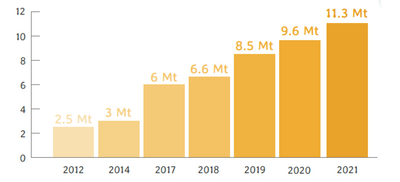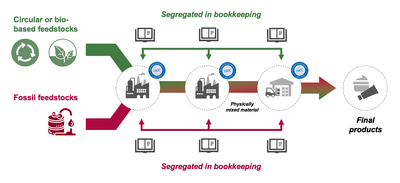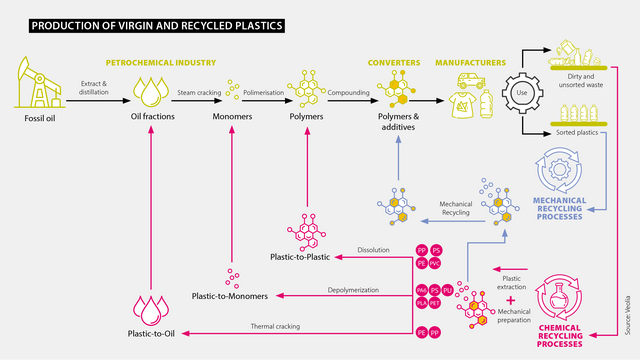Plastic Waste : Mechanical Recycling vs. Chemical Recycling: Rivals or Partners?

“Plastics are all around us, they’re everywhere we go!”. It sounds like a Wet Wet Wet song. OK, they may not have sung exactly those words, but that doesn’t make them any less true. This durable, versatile and affordable material has very much shaped our world. For better – and for worse. Just look at current levels of plastic pollution. Back in the late 1980s it was already becoming clear that it might be a good idea to recycle plastic and not just throw it away. And the industry has come a long way since its humble beginnings in the form of inhouse, post-industrial waste recycling. The first recycling plants processed mainly PET bottles, but the technology at that time did not allow for closed loop applications of recyclates. Fast forward two decades: Thanks to research and innovation, the plastics recycling industry is making headway in high-quality recycling. Recyclates can be used in a wide range of sectors, including food-grade applications. And a few years ago, ‘chemical recycling’ made its big entrance, promising to deal with the plastic waste that mechanical recycling cannot treat.
There is now a big question looming over the industry: Are they rivals? Or are they partners?
Definition of Recycling
The European Waste Framework Directive defines recycling as “any recovery operation by which waste materials are reprocessed into products, materials or substances, whether for the original or other purposes. It includes the reprocessing of organic material but does not include energy recovery and reprocessing into materials that are to be used as fuels or for backfilling operations.”
Want to stay up-to-date on our content? Subscribe to our newsletters!
Mechanical Recycling
“Mechanical recycling, also referred to as physical recycling, involves the processing of plastic materials without altering their chemical structure,” explains Antonino Furfari, Managing Director of Plastics Recyclers Europe. “Instead, they are subject to a series of steps that alter the physical form of the materials, like grinding and melting. These steps purify the material without breaking the polymeric chains.”
Mechanical recycling processes vary depending on the polymer to be treated, the waste stream it comes from and the intended application. “However, the most typical process involves technologies which firstly shred the input material into smaller fragments, called flakes. These fragments are then washed in designated tanks and during that same process the material is separated based on the distinguishable densities of different polymers,” Furfari explains.
Further Reading: Austrias Top 1000 Managers. An analytical mapping of the leadership of Austrian Industry.
These washed flakes can be converted directly into new plastic products, depending on their intended use. Alternatively, the material is processed through extruders, where it is melted, filtered and finally granulated into pellets. “For high-quality end applications, recyclers will often include additional sorting steps in their facilities or introduce specific washing and decontamination conditions. The latter is important when recycled materials are used in products intended to come into contact with food,” says Furfari.
-
1
![© PRE Antonino Furfari PRE]() “Chemical recycling could have the potential to further accelerate a circular plastic future if it can treat the waste which cannot currently be mechanically recycled into high-quality plastics.”
“Chemical recycling could have the potential to further accelerate a circular plastic future if it can treat the waste which cannot currently be mechanically recycled into high-quality plastics.”Antonino Furfari, Managing Director of Plastics Recyclers Europe
The most common plastics recycled through mechanical processes are PET and HDPE LDP, PP, PVC and PS. The technology has improved vastly over the last couple of years. Optical and sensor-based technologies, such as near-infrared (NIR), mid-infrared (MIR) and hyperspectral imaging, allow for more higher-quality input material thus making mechanical recycling possible for basically all plastics except heavily contaminated plastic waste, products made with a combination of non-separable materials or plastics made with high concentrations of additives that alter the intrinsic properties.
“Depending on the feedstock and process, it is important to emphasise that it is possible to produce the highest grades of circular polymers, even food-grade (FG) polymers, in high volumes for FG r-PET but lower volumes for FG r-PE or r-PP,” says Benoît Perreau, Markets & Clients Director, Solid Waste, Recycling & Recovery at Veolia. He continues: “We should also never forget that mechanical recycling is a technology in constant evolution and improvement. Indeed, thanks to the development of circular loops for ‘green to green’ bottles or ‘tray to tray’ in operation in several plants, what was not possible yesterday, becomes possible today.”
PET is a prime example of successful mechanical recycling. PET bottles made from 100 per cent r-PET are becoming more and more the rule. However, the picture is not so rosy when looking at non-PET materials. Although mechanical recycling solutions are available with FDA (US Food and Drug Administration) approval for defined input streams, their use in the EU is severely limited by current EFSA (European Food Safety Authority) evaluation criteria. No wonder then that chemical recycling is attracting increasing interest.
Chemical Recycling
“Here in Europe and for Chemical Recycling Europe we define chemical recycling to be any reprocessing technology that directly affects either the formulation of the polymeric waste or the polymer itself and converts them into chemical substances and/or products whether for the original or other purposes, excluding energy recovery,” explains John Sewell, Secretary General of Chemical Recycling Europe.
For condensation polymers such as PET, depolymerisation technologies are used for chemical recycling, whereas for polyolefins, which are most common in food contact applications and represent the majority of plastic types in European waste, thermal cracking technologies such as pyrolysis, hydrothermal treatment are the technologies best suited to waste streams containing such polymers. Gasification is also seen as a chemical recycling technology that has its place in relevant solutions.
-
1
![© CRE John Sewell CRE SW]() “Chemical recycling is not monolithic, there are different technologies to address different polymer waste streams. What is relevant is to compare chemical recycling to current end-of-life options to see where it can make things better in terms of footprint, circularity and replacement of fossil-based plastics.”
“Chemical recycling is not monolithic, there are different technologies to address different polymer waste streams. What is relevant is to compare chemical recycling to current end-of-life options to see where it can make things better in terms of footprint, circularity and replacement of fossil-based plastics.”John Sewell, Secretary General Chemical Recycling Europe
“Unfortunately, not all plastics can easily be mechanically recycled. Certain types of plastics, such as films and flexibles, are typically either destined for landfill, incineration or end up in our oceans, where it is estimated that eight million tonnes of plastic are dumped every year. This is where chemical recycling has a big part to play in treating these plastics, as well as having other advantages in terms of its final product,” says Carlos Monreal, CEO of Plastic Energy. “Unlike mechanical recycling, which downgrades plastics (with the exception of PET bottles), chemical recycling recycles plastics again and again, with no deterioration of quality.”
Agilyx CEO Tim Stedman adds: “Chemical recycling can serve a purpose in recycling plastics that are too complex, too contaminated, or in some other way inappropriate for a mechanical stream.”
The chemical recycling industry is still currently in its infancy. “As of the second half of 2022, total chemical recycling capacities for all plastics and technologies amounted to around 100,000 tonnes. By 2025 this is expected to increase by an order of magnitude to around 1.2 million tonnes,” says Sewell. Compared to the sheer volume of plastic production – and recycling – this does not yet represent a significant proportion.

“Just like any nascent industry, there are some economic challenges with chemical recycling because the investment is not yet there,” Stedman says. “As companies start to more seriously fund these technologies and work to make advances in the feedstock supply chain, the economics will become much more favourable.”
Plastic Recycling in Numbers
According to the report Plastics – The Facts 2022 published by Plastics Europe, post-consumer recycled plastics represented 8.3 per cent (32.5 Mt) of the 390.5 Mt of plastics produced worldwide in 2021. The majority of plastics production (44 per cent) consists of packaging.
Production in Europe increased to 57.2 Mt in 2021, of which 8.5 Mt or 10.1 per cent are post-consumer recycled plastics.
The report further highlights the fact that in 2020, 29.5 million tonnes of post-consumer plastics waste were collected in the EU27+3. It notes that the recycling rate of plastic waste is about 13 times higher when it is collected separately than when it is collected in mixed waste collection schemes. For packaging waste, this figure increases to 80 times higher.
This effect is also seen as important by the industry: “In combination with sorting behaviours at source which are to be promoted and incentivised as far as possible, sorting/presorting of mixed waste streams is a key success factor to increase the availability of segregated streams allowing the development of real circularity,” Perreau argues. “Separate collection will remain the preferred option for household collection, allowing for the massification of the sorting steps in MRFs (material recovery facility) and PRFs (plastic recycling facility).”
The Netherlands, Norway, Spain and Germany have recycling rates over 40 per cent. Germany, Spain, Italy, the United Kingdom and France are the countries with the highest installed capacities in Europe, Furfari notes: “Together, they represent more than two-thirds of the total.” The Netherlands as well as Poland have stood out in recent years as countries with notable growth in recycling capacities.
With overall growth of 33% in the last three years alone, the plastics recycling industry is expanding rapidly in Europe.
-
1
![© Agilyx Tim Stedman Agilyx SW]() “The real issue facing recycling is the lack of reliable access to quality feedstock in order to feed recycling technologies of any kind.”
“The real issue facing recycling is the lack of reliable access to quality feedstock in order to feed recycling technologies of any kind.”Tim Stedman, CEO Agilyx
Criticism of Chemical Recycling
Chemical recycling is not loved by everyone in the industry. Last year, the American Institute of Scrap Recycling Industries (ISRI) published a position paper, defining which technologies should be labelled as recycling, and which not. “As new recycling processes and technologies emerge to help address the increasing variety of plastics and plastics products in commerce, it is important to properly identify these processes and technologies and define them appropriately,” ISRI stated. “Plastics recycling is a series of activities that processes end-of-life plastic materials into marketable commodities that are subsequently consumed in lieu of virgin materials as feedstock in the manufacture of material products and not in the production of energy or fuels.
Non-mechanical processes that convert plastics at the end of life into recycled resins and monomers are recycling as they are producing materials to be ‘consumed in lieu of virgin materials as feedstock in the manufacture of material products and not in the production of energy or fuels.’
Non-mechanical processes that convert plastics at the end of life into petrochemical products that are fuels or used to make fuels do not meet ISRI’s above definition of plastics recycling and thus cannot be properly considered recycling."
Another frequent criticism is the high energy consumption and lack of maturity of the technologies. “All the various chemical recycling processes (dissolution, depolymerisation and thermal cracking / pyrolysis) show a much lower maturity (only a handful of industrial projects over the world) and have a severely worse GHG footprint,” Benoit Perreau explains. “By order of maturity, pyrolysis applied on ‘plastic to plastic’ today shows a GHG footprint higher than virgin, and a very poor material recycling yield (max. 30 to 40 per cent after vapocracking), which makes the promise of ‘infinite recycling’ an illusion. Dépolymerisation and Dissolution announce slightly better GHG footprint than virgin and very good yields.” He adds: “Mechanical recycling is and will remain the preferred recycling solution as it is by far the most efficient when applicable and has demonstrated itself to be the most beneficial to climate change mitigation.”
-
1
![© Erema Klaus Lederer Erema]() “Mechanical processes often stand at the beginning of the chemical recycling process chain to handle post-consumer input streams. This ensures a reliable, continuous and energy-efficient material feed into the chemical recycling process and leads to a consistent output quality.”
“Mechanical processes often stand at the beginning of the chemical recycling process chain to handle post-consumer input streams. This ensures a reliable, continuous and energy-efficient material feed into the chemical recycling process and leads to a consistent output quality.”Klaus Lederer, Business Development Manager-Chemical Recycling, Erema Group
Research on low-temperature Chemical Recycling
One of the main points of criticism regarding chemical recycling is energy intensity. Over the last couple of years therefore researchers have looked into if – and how – plastic recycling is possible at lower temperatures.
In 2022, a team of researchers at the Centre for Sustainable and Circular Technologies (CSCT) at the University of Bath published their results on a mild and fast chemical recycling process for polycarbonates, a tough class of plastics that are widely used in the construction and engineering industries. By using a zinc-based catalyst and methanol, they were able to completely break down commercially available poly(bisphenol A carbonate) (BPA-PC) beads within 20 minutes at room temperature. The material can then be converted into its chemical constituents, bisphenol A (BPA) and dimethyl carbonate (DMC), helping to maintain product quality over an infinite number of cycles.
According to a statement by lead author Jack Payne, the catalyst is also promisingly tolerant to other commercial sources of BPA-PC (e.g. CD) and mixed waste feedstocks, thus increasing its industrial relevance, while also being amenable to other plastics (e.g. poly(lactic acid) (PLA) and poly(ethylene terephthalate) (PET)) at higher temperatures. So far, the technology has been tested on a small scale but the scientists are working on catalyst optimisation and scaling up the process.
Even more recently, researchers at the Technical University of Munich published a study on low-temperature upcycling, as they called it, of polyolefins (polyethylene, polypropylene). These materials are quite resistant to chemical degradation and dealing with their waste is therefore a real challenge. The scientists led by Wei Zhang used an aluminium chloride-based ionic liquid medium to promote the breakdown of these polyolefin plastics into liquid fuels at temperatures below 100°C. Existing recycling technologies typically need temperatures of over 200°C. The new recycling process turns plastic waste into high-quality liquid alkalenes. The alkylate product forms a separate phase and can be easily separated from the catalyst mixture with which it reacts.
Another promising technology is enzymatic recycling, i.e. using enzymes to break down plastics. Researchers at the University of Queensland (UQ) Australia led by Dr Chris Rinke from UQ’s School of Chemistry and Molecular Biosciences, have discovered a species of worm with an appetite for polystyrene. The larvae of the large black beetle (Zophobas morio), also known as superworms because of their length of about six centimetres, can eat through polystyrene thanks to a bacterial enzyme in their gut.
“Superworms are like mini recycling plants, shredding the polystyrene with their mouths and then feeding it to the bacteria in their gut,” Dr Rinke said. “The breakdown products from this reaction can then be used by other microbes to create high-value compounds such as bioplastics.” The researchers used a technique known as metagenomics to find a number of encoded enzymes that have the ability to break down polystyrene and styrene. They aim to grow the gut bacteria in the lab and further test its ability to degrade polystyrene. Engineering enzymes to break down plastic waste in recycling plants is the long-term goal.
Stay in touch with a newsletter subscription!
Frenemies?
Nevertheless, both industries seem to have realised, that the other one will not go away any time soon and that they probably need each other. As of now, they are definitely more partners than rivals – ‘frenemies’ maybe.
“Chemical recycling is not in competition with mechanical recycling”, says John Sewell. “We stand with mechanical recycling as part of the solution to the problem of plastic waste. We adhere to the waste hierarchy and complement the mix of solutions to the problem. Clearly, considering the millions of tons of plastic waste going to unfavourable end-of-life outcomes, more is needed in our tool kit.”
Klaus Lederer, Technology Research Manager-Chemical Recycling at Erema, agrees: “Chemical raw material recycling, as an additional level in the recycling pyramid between mechanical and material recycling and incineration with energy recovery, is a sensible addition in the long term to keep as much raw material as possible within the circular economy. Furthermore, mechanical processes often stand at the beginning of the chemical recycling process chain to handle post-consumer input streams. So, a reliable, continuous and energy-efficient material feed into the chemical recycling process is guaranteed and leads to a steady output quality.”
-
1
![© Plastic Energy Carlos Monreal Plastic Energy SW]() “Chemical recycling is not meant to be a replacement for mechanical recycling but rather to overcome its limitations.”
“Chemical recycling is not meant to be a replacement for mechanical recycling but rather to overcome its limitations.”Carlos Monreal, CEO Plastic Energy
Benoit Perreau adds: “Those technologies do not have to be rivals. They complement each other in tackling the double challenge of circularity and decarbonisation. Chemical recycling can be a good transitional solution to the decarbonisation of waste-to-energy plants, providing more circularity and resource conservation. However, the promise of a switch by the plastic industry from linear to circular does not look very likely in the near future.”
The Future of Plastics Recycling
The global crisis of the last few years has also left its mark on the plastics recycling industry. A number of recycling plants were forced to cease production when the pandemic first struck. In addition, due to staff shortages, waste collection services in various European regions were in decline, ultimately leading to delivery bottlenecks. “All of this put the profitability of the recycling sector in jeopardy,” states Antonio Furfari.
According to the Plastics Europe report, the war in Ukraine reinforced existing problems in supply chains and high prices for feedstock and energy. Economic growth slowed and demand for plastics fell due to high prices, particularly in Europe
The low-quality and limited supply of input materials, coupled with uncertainty on the energy market are currently the biggest challenges facing the sector. This makes legal frameworks essential for the future of the industry.
“Legislation is an important facilitator of market change as it creates a pull mechanism for investment and provides legal certainty to industry players,” Antonio Furfari says. “The targets and measures introduced in the EU Plastics Strategy, Single-Use Plastics Directive, and the Packaging and Packaging Waste Regulation (PPWR) have the potential to boost plastics recycling and enable a strong market for recycled plastic to be established.”
Carlos Monreal agrees: “Recycled content targets and EPR schemes are of the utmost importance to spur the industry forward and increase the sustainability of packaging. As governments and policymakers continue to introduce more mandatory recycled content targets for plastic packaging, chemical recycling will continue to grow due to increased demand.”
-
1
![© Benoit Perreau Veolia]() “Mechanical recycling is and shall remain the preferred recycling solution as it is by far the most efficient when applicable and has demonstrated itself to be the most beneficial to climate change mitigation.”
“Mechanical recycling is and shall remain the preferred recycling solution as it is by far the most efficient when applicable and has demonstrated itself to be the most beneficial to climate change mitigation.”Benoît Perreau, Veolia - Markets & Clients Director
Another buzzword in this context is ‘mass balance’, which the chemical recycling industry sees as essential to positive development and continuous investment in chemical recycling technologies.
The Importance of Mass Balance
“In a mechanical recycling process, separate treatment of each type of plastic is required if the recycled pellets are to be reused in direct food contact materials,” Klaus Lederer explains.
PET bottles, for example, are collected separately or sorted for processing into pellets to produce PET bottles. However, chemical recycling technologies such as pyrolysis can separate mixed plastic waste – particularly polyolefins (POs) – into their chemical components by applying thermal energy and, if required, catalysts. The resulting pyrolysis oil is a mixture of different components, including naphtha. Its quality depends on the purity of the feedstock and the treatment process used.
But it would require enormous investment to establish separate material flows for chemical recycling of plastic to plastic. “Therefore, chemically recycled materials are processed together with crude oil-based feedstocks using the existing petrochemical infrastructure (refineries, steam crackers, polymerisation plants),” says Lederer. “As a result of this process, it is no longer possible to differentiate between the original fossil chemicals and the recycled materials."
So even though packaging is increasingly labelled as ‘containing xy per cent recycled plastic’ or ‘using recycled plastic’, the actual product one is holding may contain exactly zero per cent recycled plastic.
Here is where the ‘mass balance’ approach comes in. According to the ISCC (International Sustainability & Carbon Certification), in this approach materials are mixed in production but separated in the bookkeeping. The resulting end-products can therefore be marketed separately. The big advantage? “It’s possible to further develop chemical recycling, which is just at the beginning of being industrialised, using existing infrastructure”, Lederer says.

John Sewell, Secretary General of Chemical Recycling Europe, says the association is working hard to support the definition and implementation of mass balance for chemical recycling. “What is of key importance in PPWR is changing the deadline for defining and putting in place so called mass balance accounting from 2026 to as soon as possible. We think that this will happen albeit with the leading edge of this coming first with the delegation act for SUP.”
Recycling is One Part of the Puzzle
To effectively tackle plastic waste, recycling is only one part of the solution. In addition to prevention and reuse, design-for-recycling is another key element. “Beyond recycling processes and individual ‘sorting behaviours’, the key success factor for a real circularity of plastics definitely lies with the collective responsibility of proper eco-design. The third pillar in the circular plastics economy comprises the reduction of useless plastics and poorly recyclable waste, a ban of unsortable mixed plastics and the selection of the right additives, pigments or glues. We could even say it is actually the first pillar,” Benoit Perreau argues.
The EU PPWD is definitely a move in the right direction.











